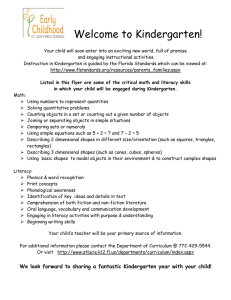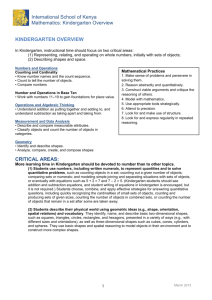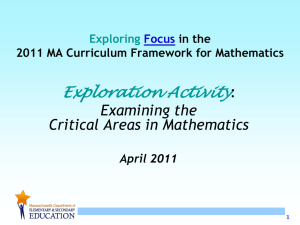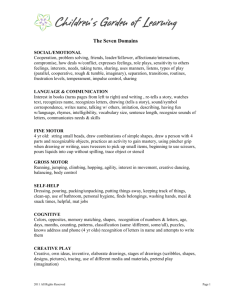Document 14923655
advertisement
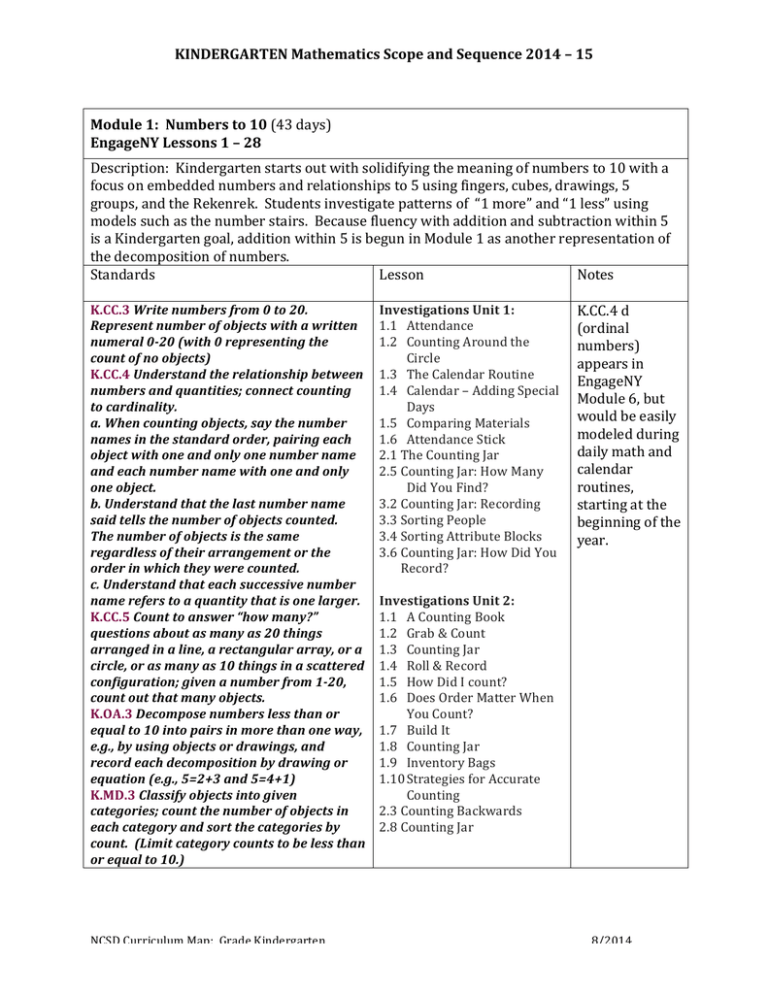
KINDERGARTEN Mathematics Scope and Sequence 2014 – 15 Module 1: Numbers to 10 (43 days) EngageNY Lessons 1 – 28 Description: Kindergarten starts out with solidifying the meaning of numbers to 10 with a focus on embedded numbers and relationships to 5 using fingers, cubes, drawings, 5 groups, and the Rekenrek. Students investigate patterns of “1 more” and “1 less” using models such as the number stairs. Because fluency with addition and subtraction within 5 is a Kindergarten goal, addition within 5 is begun in Module 1 as another representation of the decomposition of numbers. Standards Lesson Notes K.CC.3 Write numbers from 0 to 20. Investigations Unit 1: K.CC.4 d Represent number of objects with a written 1.1 Attendance (ordinal numeral 0-­‐20 (with 0 representing the 1.2 Counting Around the numbers) count of no objects) Circle appears in K.CC.4 Understand the relationship between 1.3 The Calendar Routine EngageNY numbers and quantities; connect counting 1.4 Calendar – Adding Special Module 6, but to cardinality. Days would be easily a. When counting objects, say the number 1.5 Comparing Materials modeled during names in the standard order, pairing each 1.6 Attendance Stick daily math and object with one and only one number name 2.1 The Counting Jar calendar and each number name with one and only 2.5 Counting Jar: How Many routines, one object. Did You Find? b. Understand that the last number name 3.2 Counting Jar: Recording starting at the said tells the number of objects counted. 3.3 Sorting People beginning of the The number of objects is the same 3.4 Sorting Attribute Blocks year. regardless of their arrangement or the order in which they were counted. c. Understand that each successive number name refers to a quantity that is one larger. K.CC.5 Count to answer “how many?” questions about as many as 20 things arranged in a line, a rectangular array, or a circle, or as many as 10 things in a scattered configuration; given a number from 1-­‐20, count out that many objects. K.OA.3 Decompose numbers less than or equal to 10 into pairs in more than one way, e.g., by using objects or drawings, and record each decomposition by drawing or equation (e.g., 5=2+3 and 5=4+1) K.MD.3 Classify objects into given categories; count the number of objects in each category and sort the categories by count. (Limit category counts to be less than or equal to 10.) 3.6 Counting Jar: How Did You Record? Investigations Unit 2: 1.1 A Counting Book 1.2 Grab & Count 1.3 Counting Jar 1.4 Roll & Record 1.5 How Did I count? 1.6 Does Order Matter When You Count? 1.7 Build It 1.8 Counting Jar 1.9 Inventory Bags 1.10 Strategies for Accurate Counting 2.3 Counting Backwards 2.8 Counting Jar NCSD Curriculum Map: Grade Kindergarten 8/2014 Module 2: Two-­‐Dimensional and Three-­‐Dimensional Shapes (12 days) EngageNY Lessons 1 – 10 Description: Students learn to identify and describe squares, circles, triangles, rectangles, hexagons, cubes, cones, cylinders and spheres. During this module students also practice their fluency with numbers to 10. Standards Lesson Notes K.MD.3 Classify objects into given Investigations Unit 5: categories; count the number of objects in each category and sort the categories by count. (Limit category counts to be less than or equal to 10.) K.G.1 Describe objects in the environment using names of shapes, and describe the relative positions of these objects using terms such as above, below, beside, in front of, behind, and next to. K.G.2 Correctly name shapes regardless of their orientations or overall size. K.G.3 Identify shapes as two-­‐dimensional or three-­‐dimensional K.G.4 Analyze and compare two and three dimensional shapes, in different sizes and orientations, using informal language to describe their similarities, differences, parts (e.g., number of sides and vertices/”corners”) and other attributes (e.g., having sides of equal length). 1.1 Shape Pictures 1.2 Circles & Rectangles 1.3 Triangles & Squares 1.5 Shapes on the Geoboard 2.1 Shape Mural 2.2 Pattern Block Puzzles 2.5 Our Shape Mural 3.1 Shape Hunt 3.5 Geoblock Match-­‐Up Module 3: Comparison of Length, Weight, Capacity, and Numbers to 10 (38 days) EngageNY Lessons 1 – 32 Description: Students begin to experiment with comparison of length, weight, and capacity. Students first learn to identify the attribute being compared, moving away from non-­‐ specific language such as “bigger” to “longer than,” “heavier than,” or “more than.” Comparison begins with developing the meaning of the word “than” in the context of taller than,” “shorter than,” “heavier than,” “longer than,” etc. The terms “more” and “less” become increasingly abstract later in Kindergarten. “7 is 2 more than 5” is more abstract than “Jim is taller than John.” Standards Lesson Notes K.CC.6 Identify whether the number of Investigations Unit 2: objects in one group is greater than, less than, or equal to the number of objects in another group, e.g., by using matching and NCSD Curriculum Map: Grade Kindergarten 2.4 Grab & Count: Compare 2.5 The Game of Compare 2.7 Letters in Our Name 8/2014 counting strategies. (Include groups with up to ten objects.) K.CC.7 Compare two numbers between 1 and 10 presented as written numerals. Describe and compare measurable attributes. K.MD.1 Describe measurable attributes of objects, such as length or weight. Describe several measurable attributes of a single object. K.MD.2 Directly compare two objects with a measurable attribute in common, to see which object has “more of”/”less of” the attribute, and describe the difference. For example, directly compare the heights of two children and describe one child as taller/shorter. 2.9 Comparing Names 2.10 Grab & Count Ordering 2.11 Ordering Names 2.12 Ordering Cards Investigations Unit 4: 1.1 Measuring our Shoes 1.2 Measuring Different Shoe Lengths 1.3 Measuring with Sticks 1.4 Comparing Lengths of Shoes 1.5 Measuring with Cubes Investigations Unit 6: 2.3 Measuring Ourselves Module 4: Understand addition as putting together and adding to, and understand subtraction as taking apart and taking from. (47 days) EngageNY Lessons 1 – 41 Description: Number comparison leads to a further study of embedded numbers (e.g., 3 is less than 7” leads to, “3 and 4 make 7,” and 3+4=7,). “1 more, 2 more, 3 more” lead into addition (+1, +2, +3). Students now represent stories with blocks, drawings, and equations. Standards Lesson Notes K.OA.1 Represent addition and subtraction Investigations Unit 4: with objects, fingers, mental images, drawing, sounds (e.g., claps), acting out situations, verbal explanations, expressions, or equations. (Drawings need not show details, but should show the mathematics in the problem.) K.OA.2 Solve addition and subtraction word problems, and add and subtract within 10, e.g., by using objects or drawings to represent the problem. K.OA.3 Decompose numbers less than or equal to 10 into pairs in more than one way, e.g., by using objects or drawings, and record each decomposition by a drawing or equation (e.g., 5=2+3 and 5=4+1). K.OA.4 For any number from 1 to 9, find the number that makes 10 when added to the given number, e.g., by using objects or drawings and record the answer with a NCSD Curriculum Map: Grade Kindergarten 2.2 Collect 10 Together 2.3 Build On 2.4 Roll & Record 3.2 Story Problems 3.3 One More, One Fewer 3.4 Double Compare 3.5 More or Less at the End 3.6 Build It/Change It 3.7 Who has More? 4.1 Six Tiles in All 4.2 Quick Images-­‐Square Tiles 4.3 Arrangements of 5 to 10 tiles 4.4 Toss the Chips 4.5 Quick Image in Pairs 4.6 Combinations of 6 4.7 Arrangements of 6 Investigations Unit 6: 8/2014 drawing or equation. K.OA.5 Fluently add and subtract within 5. 3.3 Modeling Story Problems 3.4 Build & Remove 3.5 How Many Balls 3.6 How Do You Show the One That is Gone? 3.7 How Many Balls? 4.1 Five Crayons in All 4.2 Combinations of Six 4.3 Total of Six 4.4 Six Crayons in All 4.5 More Combinations Of Six Module 5: Know number names and count the sequence (30 days) EngageNY Lessons 1 – 24 Description: After students have a meaningful experience of addition and subtraction within 10 in Module 4, they progress to exploration of numbers 10-­‐20. They apply their skill with an understanding of numbers within 10 to teen numbers, which are decomposed as “10 ones and some ones.” For example, “12 is 2 more than 10.” The number 10 is special; it is the anchor that will eventually become the “ten” unit in the place value system in Grade 1. Standards Lesson Notes K.CC.1 Count to 100 by ones and tens. Investigations Unit 4: The math K.CC.2 Count forward beginning from a 2.1 Revisiting Counting workshop portion given number within the known sequence (Up To 20) of these sessions (instead of having to begin at 1). 2.5 Quick Images: Ten may include K.CC.3 Write numbers from 0 to 20. Frames activities from Represent a number of objects with a 3.1 Racing Bears previous modules. written numeral 0-­‐20 (with 0 representing a Feel free to swap count of no objects). Investigations Unit 6: these activities out K.CC.4 Understand the relationship between 2.1 Collect 15 Together for activities that numbers and quantities: connect counting 2.2 Inventory Bags support your to cardinality. 2.4 Do We Have to Count current unit of a. When counting objects, say the number Them All? names in the standard order, pairing each 2.5 How Did You Count? study. object with one and only one number name and each number name with one and only one object. b. Understand that the last number name said tells the number of objects counted. The number of objects is the same regardless of their arrangement or the order in which they were counted. c. Understand that each successive number name refers to a quantity that is one larger. K.CC.5 Count to answer “how many?” NCSD Curriculum Map: Grade Kindergarten 2.6 Representing an Inventory 3.1 Roll and Record 3 3.2 Double Compare Investigations Common Core Supplement: 5A.3 The Teen Numbers 5A.4 Roll and Record Teen Numbers 5A.5 Teen Numbers 8/2014 questions about as many as 20 things arranged in a line, a rectangular array, or a circle, or as many as 10 things in a scattered configuration; given a number from 1-­‐20, count out that many objects. K.NBT.1 Compose and decompose numbers from 11 to 19 into ten ones and some further ones, e.g., by using objects or drawings and record each composition or decomposition by a drawing or equations (such as 18=10+8); understand that these numbers are composed of ten ones and one, two, three, four, five, six, seven, eight, or nine ones. Module 6: Analyzing, Comparing, and Composing Shapes (10 days) EngageNY Lessons 1 – 8 Description: Module 6 rounds out the year with an exploration of shapes. Students build shapes from components, analyze and compare them, and discover that they can be composed of smaller shapes, just as larger numbers are composed of smaller numbers. Standards Lesson Notes K.CC.4 Understand the relationship between Investigations Unit 5: Investigations Unit numbers and quantities: connect counting 1.4 Clay Shapes 6, investigation 1 is to cardinality. 1.6 Our Book of Shapes a review of d. Develop understanding of ordinal 2.3 Fill the Hexagons previous modules. numbers (first through tenth) to describe the relative position and magnitude of whole numbers. K.G.4 Analyze and compare two and three dimensional shapes, in different sizes and orientations, using informal language to describe similarities, differences, parts (e.g., number of sides and vertices/”corners”) and other attributes (e.g., having sides of equal length). K.G.5 Model shapes in the world by building shapes from components (e.g., sticks and clay balls) and drawing shapes. K.G.6 Compose simple shapes to form larger shapes. For example, “Can you join these two triangles with full sides touching to make a rectangle?” 2.4 Combining Shapes 2.6 Ways to Make a Hexagon 3.2 A Close Look Geoblocks 3.3 Copying Cubes & Matching Faces 3.4 More Clay Shapes 3.6 Build a Block NCSD Curriculum Map: Grade Kindergarten 8/2014
